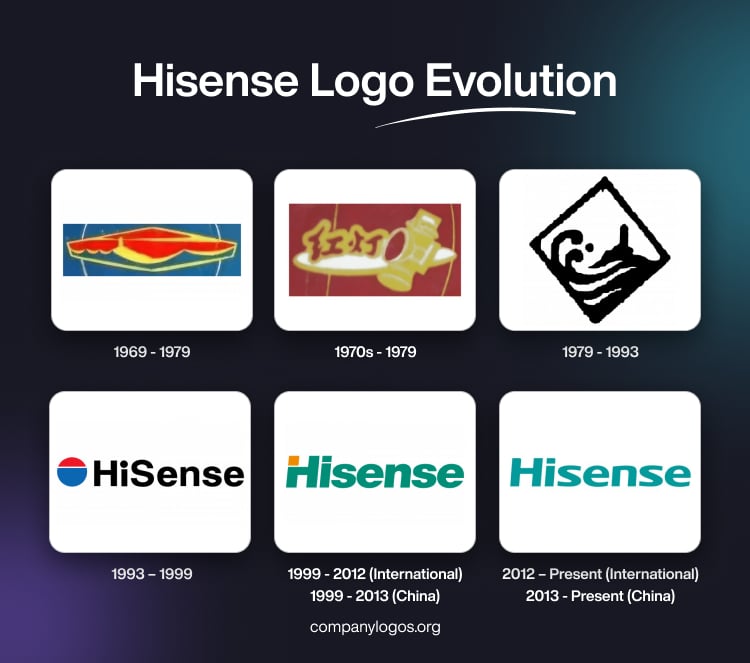
Hisense is a Chinese multinational with expertise in consumer electronics and home appliances. Its journey began as a small factory to produce radios but has become a global brand. Hisense has a rich product portfolio comprising televisions, air conditioners, refrigerators, mobile devices, and washing machines. The brand name comprises two words: “Hi” as a greeting and “Sense” as a feeling.
The Hisense logo has undergone a few changes, and these iterations reflect the brand’s journey from a local Chinese manufacturer to a global force in consumer electronics. The article delves into the various logo changes for Hisense, among other details of the company.
The Genesis of the Hisense Logo (1969 – 1979)
The original avatar of Hisense, the Qingdao No. 2 Radio Factory, had a logo that featured a stylised red lantern, the very first product of the company. Also, the radio stations appeared horizontally in red and yellow against a blue background. Incidentally, there was no logotype accompanying the graphical emblem.
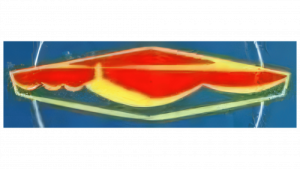
(1970s – 1979)
In another logo iteration, there was an emblem comprising the image of a handsaw in gold and burgundy. The brand name was written in the centre, followed by the image of a lantern. The logo looked solid and stable, thanks to the thick gold outlines of the emblem.
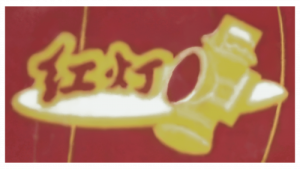
(1979 – 1993)
The logo during this period featured a minimalist black-and-white rhomboid emblem with the image of a lighthouse and waves. Black strokes were used to draw the image against a white background. Interestingly, there was no inscription accompanying the emblem.

(1993 – 1999)
By 1993, the logo comprised a circular emblem in red and blue, accompanied by the brand name in black and rendered using a traditional sans-serif typeface. Also, the letters “H” and “S” appeared in uppercase. Incidentally, the logo, especially the emblem, was somewhat similar to the Pepsi logo, which made it untenable for the company.
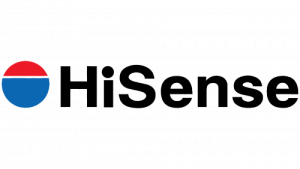
(1999 – 2012) (International), (1999 – 2013) (China)
Devoid of any emblem, the logo iteration of 1999 saw the logotype in a title case. Rendered in green and paired with an orange accent, the logo looked saturated but bright. The first letter “H” had a tiny but thick orange accent to the top left of its vertical bar. The letters were elongated and had traditional curves, especially with the letter “s”.
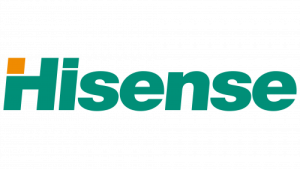
(2012 – Present) (International), (2013 – Present) (China)
Hisense modernised its visual identity once again in 2012 to reflect its rise as a global market leader. The current logo retains the clean custom sans-serif “Hisense” wordmark but without the orange accent. It has opted for a single shade of teal to embody simplicity, memorability, and a focus on brand recognition. The choice of colour emphasises the technological nature of the company and its inventiveness.
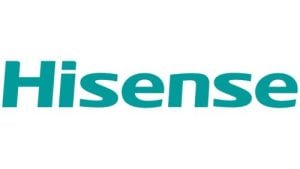
The Elements of the Hisense Logo
Font
The wordmark of the Hisense logo contains highly legible letters and is rendered using the popular sans-serif typefaces.
Colour
The colour palette of the latest Hisense logo comprises a light shade of teal or green.
The History of Hisense
The journey of Hisense began as the Qingdao Number 2 Radio Factory in September 1969 by Qingdao governmental authorities. Its first product was a radio branded as Red Lantern. In the early 1970s, the company acquired expertise in television manufacturing, especially black and white televisions. It then progressed to producing transistor TVs by 1975.
In 1978, the factory started producing TVs under the Qingdao brand, which quickly gained popularity across China. Due to China’s push to develop the consumer electronics sector after 1979, the factory merged with other local electronics makers and became known as Qingdao General Television Factory. It also began manufacturing colour televisions through technology purchases from leading international brands such as Matsushita, Hitachi, and Toshiba.
The modern Hisense Group emerged in 1994 and was driven by significant leadership changes and strategic growth. It was publicly listed on the Shanghai Stock Exchange in April 1997. The company expanded aggressively in the 1990s and acquired failing enterprises. It also diversified into manufacturing household appliances, computers, and communications.
Hisense launched import and export operations in 1988 and participated in the Canton Fair in 1993, which opened doorways for the company to international markets. The brand name “Hisense” was registered in 1993. Expansion followed with branch offices being set up globally in markets such as South Africa, Australia, Europe, and North America.
Key moments in recent history include the acquisition of Sharp’s Mexico facility in 2015 and majority stakes in companies like Toshiba Visual Solutions and Slovenian appliance manufacturer Gorenje. Hisense has continually invested in R&D. It develops its own video processing chips and collaborates in large-scale ventures such as joint ventures with Hitachi for commercial air conditioning systems.
The company is a leader in smart TVs, air conditioners, washing machines, and refrigerators and offers durable, energy-efficient devices globally. Hisense was a sponsor of the 2018 FIFA World Cup, which further cemented its global reputation. It goes without saying that Hisense remains one of the most innovative and reliable brands in the home electronics and appliances industry.
Interesting Facts About Hisense
- Hisense started as a small radio factory in Qingdao, China, and has since grown into one of the world’s largest electronics and appliance manufacturers.
- The company operates in over 160 countries and regions, with more than 50 overseas companies and offices.
- While best known for televisions, Hisense also manufactures refrigerators, washing machines, air conditioners, smartphones, and even medical equipment.
- Hisense is one of the top TV brands globally and is often ranked among the top 5 in terms of sales. It is particularly strong in markets like China, South Africa, and Australia.
- In 2017, Hisense acquired a majority stake in Toshiba’s TV business, which gave it access to advanced technologies and strengthened its international presence.
- Hisense has been an official sponsor of major global sporting events, including the FIFA World Cup (2018, 2022) and UEFA EURO tournaments.
- The company is a pioneer in ULED (Ultra LED) and Laser TV technologies, thereby pushing boundaries in picture quality and display innovation.
- Hisense integrates AI and IoT features into many of its appliances to make them smarter and more energy-efficient.
- Hisense has a major factory in Cape Town, South Africa, which manufactures TVs and refrigerators for the African market.
- Hisense emphasises eco-friendly practices. It develops energy-efficient appliances and aims to reduce carbon emissions across its production lines.
- The company employs 90,000+ people worldwide, which makes it one of the largest employers in the consumer electronics sector.
- Beyond electronics and appliances, Hisense also has investments in real estate, IT services, and optical communications.
Finally
The logo evolution of Hisense reflects the journey of a company, especially from emblematic simplicity to a globally unified wordmark. The logo embodies its ongoing push for technological relevance, brand consistency, and broad international appeal.